Social media tools are essential for managing, analyzing, and improving your online presence. Whether you’re a small business or a large enterprise, these platforms streamline tasks like scheduling posts, tracking performance, and engaging with your audience. Here’s a quick breakdown of the top tools:
- Sprout Social: Advanced analytics, multi-platform scheduling, and integrations. Starts at $249/month.
- HubSpot Marketing Hub: Combines social media management with CRM. Plans from $45/month.
- Hootsuite: Popular for managing multiple accounts and team collaboration. Starts at $99/month.
- Buffer: Simple scheduling and analytics, ideal for small teams. Free plan available; paid plans from $6/month.
- Zoho Social: Great for businesses using Zoho products. Starts at $10/month.
- CoSchedule: Focuses on content planning and team workflows. Starts at $29/month.
- Birdeye: Adds reputation tracking alongside social tools. Starts at $299/month.
- SOCi: Tailored for multi-location businesses. Custom pricing.
- Thryv: Designed for small businesses, with social insights and customer management. Starts at $39/month.
These tools cater to different needs, from solo entrepreneurs to large organizations. Choose based on your budget, team size, and goals.
1. Sprout Social
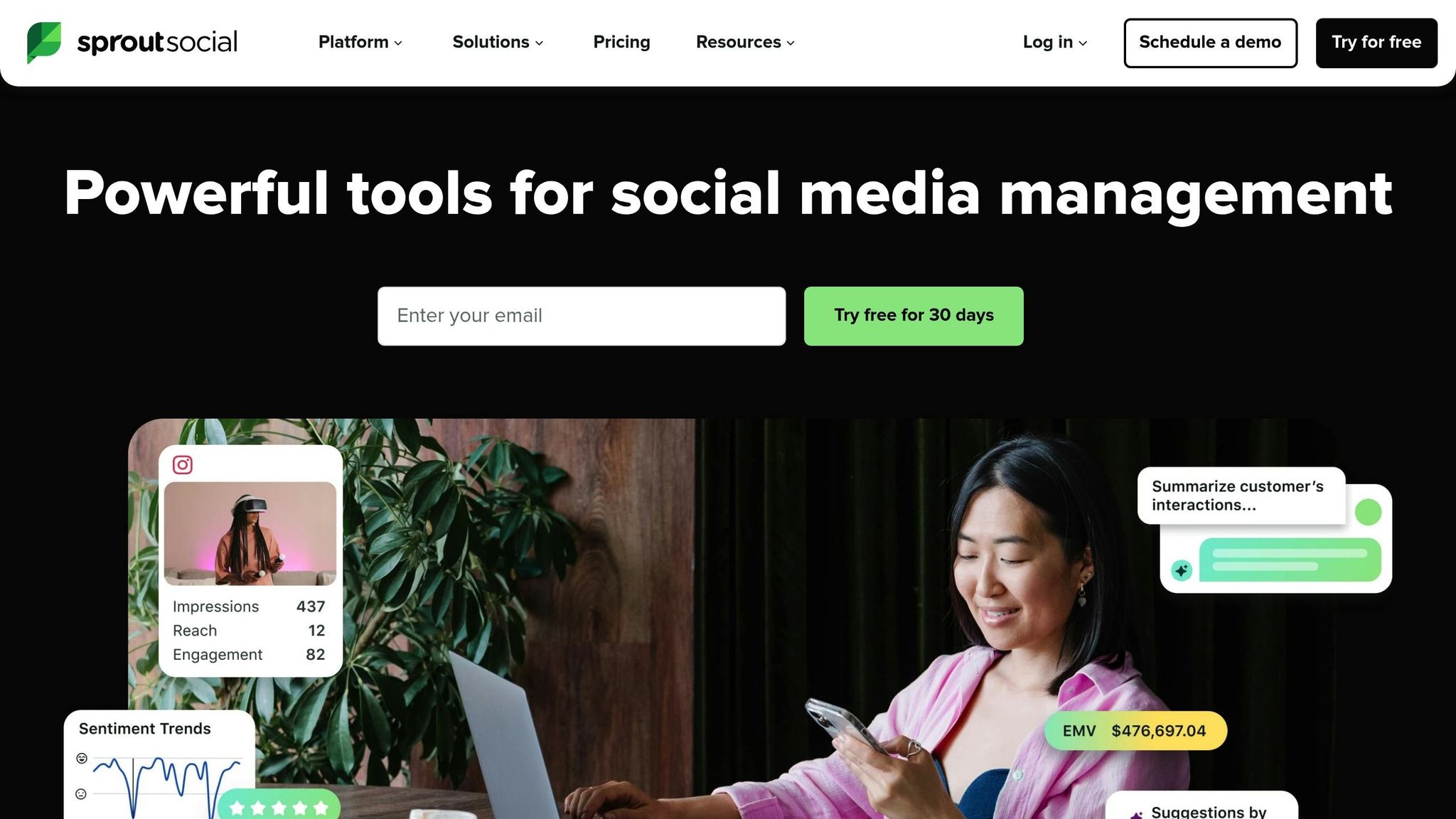
Sprout Social simplifies multi-channel marketing by combining strategic content management with actionable insights. Here’s a closer look at its standout features in scheduling, analytics, integrations, and pricing.
Social media management and scheduling
Sprout Social makes it easy to schedule and publish content across platforms like Facebook, Twitter, Instagram, LinkedIn, Pinterest, and YouTube – all from one dashboard. Its Smart Inbox consolidates social messages, helping teams respond quickly and maintain consistent communication.
One of its standout features, ViralPost, studies audience engagement patterns to recommend the best times to post, ensuring your content reaches more people when they’re most active.
Analytics and reporting capabilities
Sprout Social goes beyond basic metrics, offering tools like sentiment analysis and share of voice to give you a deeper understanding of your brand’s performance and perception on social media.
The platform also allows teams to create custom, branded reports that highlight ROI and campaign results for stakeholders. These reports can be automated and scheduled for regular updates, saving time while keeping everyone informed about key performance metrics.
Integration with other tools and platforms
Sprout Social integrates seamlessly with popular tools like Salesforce, HubSpot, Google Analytics, and Zendesk, creating a unified view of social and sales data.
For businesses with unique needs, the platform offers API access, enabling custom integrations with proprietary systems or niche marketing tools. This adaptability makes it a strong choice for companies with complex tech setups.
Pricing and scalability for businesses of different sizes
Sprout Social offers tiered pricing, starting at $249/month for five social profiles and basic analytics. More advanced plans at $399 and $499/month include enhanced reporting features and collaboration tools.
For larger organizations, the Enterprise plan offers custom pricing and includes advanced security, workflow management, and dedicated customer support. This range of options ensures businesses of all sizes can find a plan that fits their needs while improving their online presence.
2. HubSpot Marketing Hub
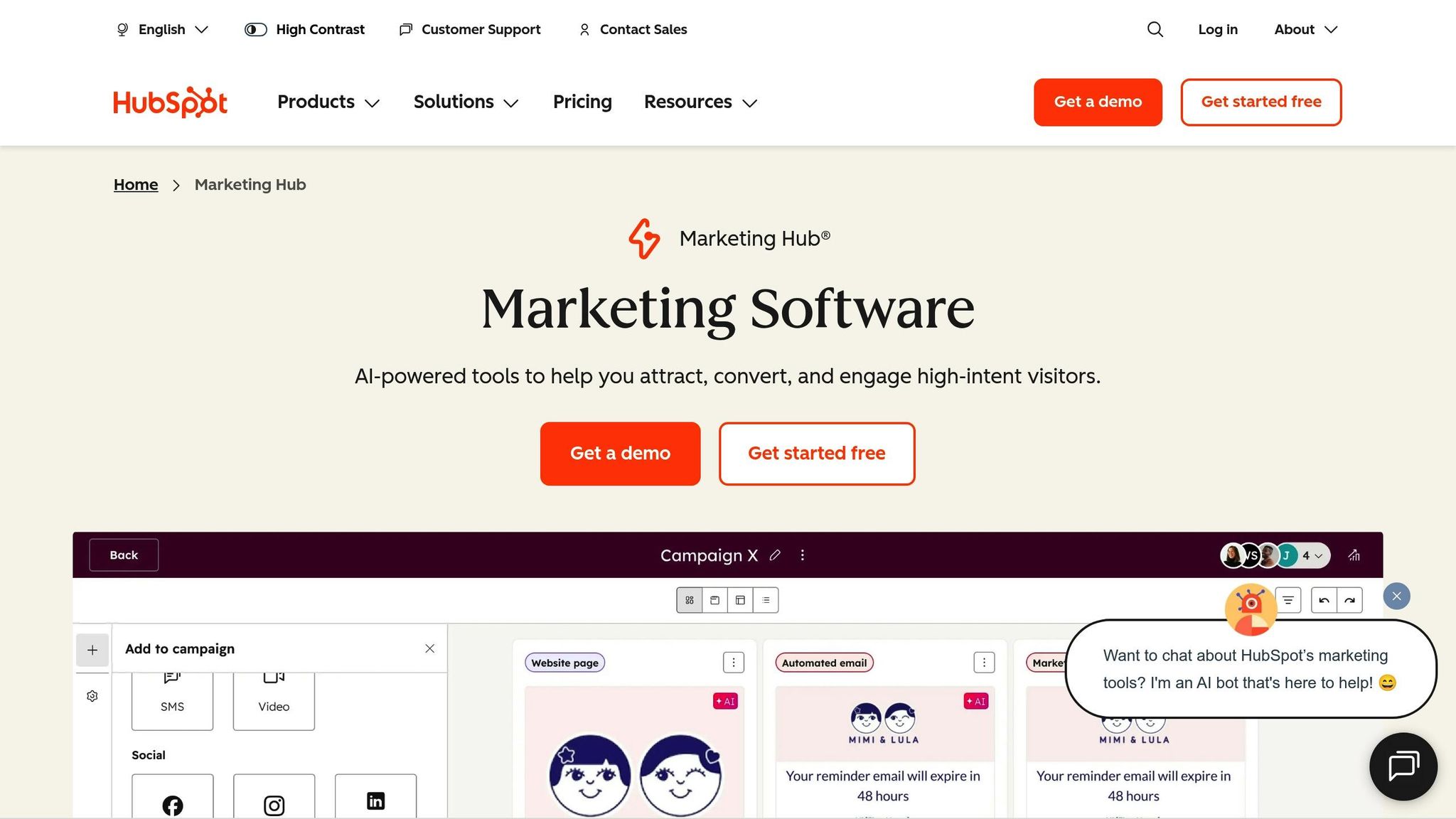
HubSpot Marketing Hub combines social media management and CRM tools into one powerful platform, designed to connect social media efforts with lead generation and customer management. It goes beyond basic social tools by directly linking social activity to customer data, offering a more cohesive marketing experience.
Social Media Management and Scheduling
With HubSpot Marketing Hub, you can manage and schedule content across multiple social networks from a single dashboard. This streamlined setup helps teams plan posts efficiently while staying connected with their audience.
Analytics and Reporting
The platform provides detailed analytics to show how social media efforts impact business results. Customizable dashboards make it easy to track key performance metrics and evaluate the success of campaigns.
Integrations That Work Together
HubSpot’s built-in CRM and marketing tool integrations simplify customer data management. Social interactions automatically feed into your overall marketing strategy, ensuring everything works seamlessly together.
Flexible Plans for Growth
Whether you’re running a small business or managing a large enterprise, HubSpot Marketing Hub offers plans to suit your needs. With options for various budgets and growth stages, it’s a solution that adapts as your business evolves.
3. Hootsuite
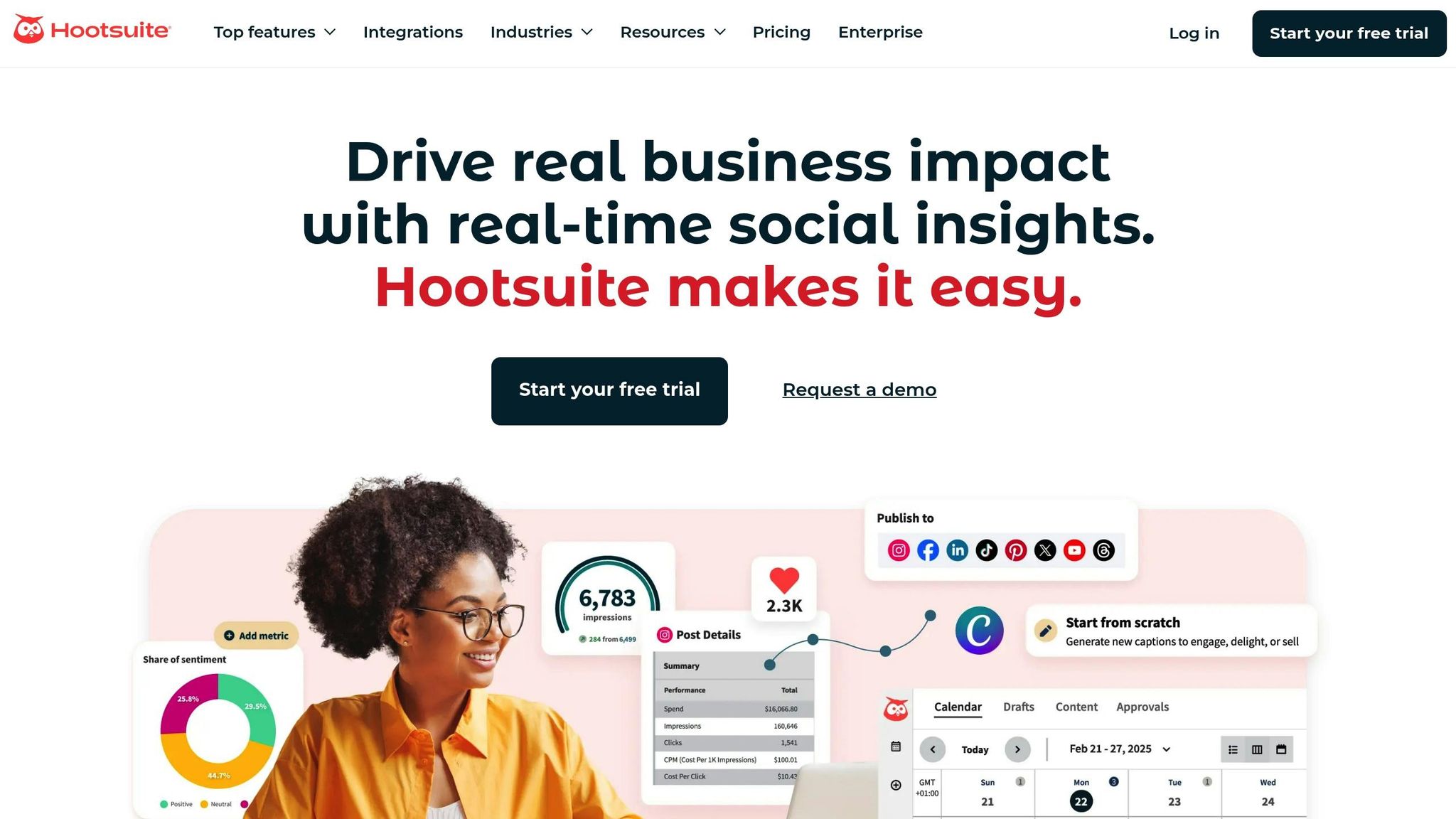
Hootsuite stands out as a well-established platform designed to simplify social media management. It brings all your social channels together, making it easier to maintain consistent messaging, streamline operations, and engage effectively with your audience.
Social Media Management and Scheduling
Hootsuite’s scheduling tools let you plan posts individually or in bulk using CSV uploads. With its visual calendar, you can schedule content for weeks or even months in advance, ensuring your posts remain consistent during peak seasons or holidays.
The calendar provides a clear snapshot of your posting plan, helping you quickly identify gaps or overlaps in your strategy. Plus, its collaboration features make teamwork seamless – allowing reviews and approvals to keep your brand messaging on point.
Analytics and Reporting Features
Hootsuite offers robust analytics to monitor engagement, audience growth, and the performance of your posts across all connected platforms. Its dashboard highlights essential metrics like reach, impressions, clicks, and engagement rates. You can also generate custom reports and schedule them for automatic delivery to stakeholders.
Additionally, you can track competitors’ metrics to identify opportunities for improvement. The platform’s ROI tracking tools connect social media efforts to business results by measuring website traffic, lead generation, and conversions originating from social channels.
Integration with Other Tools and Platforms
Hootsuite integrates with over 150 third-party apps, including popular tools like Mailchimp, Salesforce, Google Analytics, and Canva, making it easier to streamline your marketing processes.
Its app directory offers specialized tools for tasks like content creation, customer service, and social listening. For businesses needing custom solutions, API access allows integration with existing software systems.
The platform also supports CRM integrations, enabling you to track social media interactions within your customer relationship management system for a comprehensive view of customer touchpoints.
Pricing and Scalability for Various Business Needs
Hootsuite offers several pricing tiers to accommodate businesses of different sizes:
- Professional plan: $99/month, ideal for small teams managing up to 10 social accounts.
- Team plan: $249/month, supports up to 20 accounts and includes collaboration tools.
- Business plan: $739/month, designed for larger organizations with advanced analytics, custom branded reports, and up to 35 social accounts.
- Enterprise options: Custom pricing for businesses needing extensive customization and dedicated support.
The platform is designed to scale with your business, offering advanced features like custom workflows, user permissions, and dedicated account management at higher tiers. Whether you’re a small business or a large enterprise, Hootsuite adapts to meet your growing social media needs.
Up next, we’ll dive into tools that take campaign management and customer engagement to the next level.
4. Buffer
Buffer is a straightforward social media management tool that combines a sleek, modern design with practical features to make scheduling and publishing content a breeze.
Social Media Management and Scheduling
Buffer simplifies scheduling for multiple social platforms with its visual calendar, which lets you plan posts weeks in advance. Need to make changes? The drag-and-drop feature makes rescheduling quick and easy.
Instagram users will appreciate Buffer’s reliable posting capabilities and its intuitive interface, which previews how your posts will appear across different networks. The platform doesn’t stop at desktop functionality – Buffer’s mobile apps for iOS and Android ensure you can manage your accounts and share content on the go. Plus, the browser extension makes it simple to add links, images, or videos directly to your Buffer queue while browsing.
Another standout feature is Buffer’s Start Page, which helps you create personalized link-in-bio landing pages to make the most of your social profiles.
Analytics and Reporting Capabilities
Buffer provides a straightforward analytics dashboard that tracks engagement, reach, clicks, and follower growth. It also includes a UTM Generator, which allows you to create trackable links for campaigns. This makes it easier to see which social media efforts are driving traffic and conversions.
However, Buffer doesn’t offer recommendations for optimal posting times based on audience data, meaning you’ll need to rely on your own insights or those provided by the native platforms. Additionally, it lacks YouTube analytics, which could be a downside if video content plays a significant role in your marketing strategy.
Integration with Other Tools and Platforms
Buffer integrates seamlessly with a range of tools to streamline your workflow. For design needs, it connects with Canva, allowing you to create and import visuals directly into your posts. It also works with cloud storage services like Dropbox, Google Drive, OneDrive, and Google Photos, making it easy to access your assets.
Need stock photos? Buffer’s Unsplash integration provides a wide selection, while Bitly handles link shortening and tracking. The platform also includes an AI Assistant powered by OpenAI, which helps craft more engaging posts using natural language processing.
For agencies or larger teams, Buffer connects with over 400 apps through Zapier, automating tasks and boosting efficiency. WordPress users can automatically share blog posts to social media, and tools like Quuu offer curated content suggestions to keep your feeds fresh with relevant updates.
Pricing and Scalability for Businesses of Different Sizes
Buffer’s free plan is a great starting point for small businesses or individuals looking to explore its core features. This makes it especially appealing to startups and entrepreneurs beginning their social media journey.
Paid plans are designed to grow with your business, accommodating more social accounts and team members as needed. With a clear and competitive pricing structure, Buffer focuses on delivering reliable functionality without overwhelming users with unnecessary features.
As Efficient.app Review 2025 highlights, "The learning curve is small when it comes to using the app, they have a great mobile app, and the app is a clear winner when it comes to content scheduling" .
Buffer is particularly effective for managing Twitter and LinkedIn accounts. However, some users find manual posting better for TikTok and YouTube Shorts, citing limitations with caption formatting and thumbnail options.
Next, we’ll dive into Zoho Social’s offerings to see how it can complement your social media strategy.
5. Zoho Social
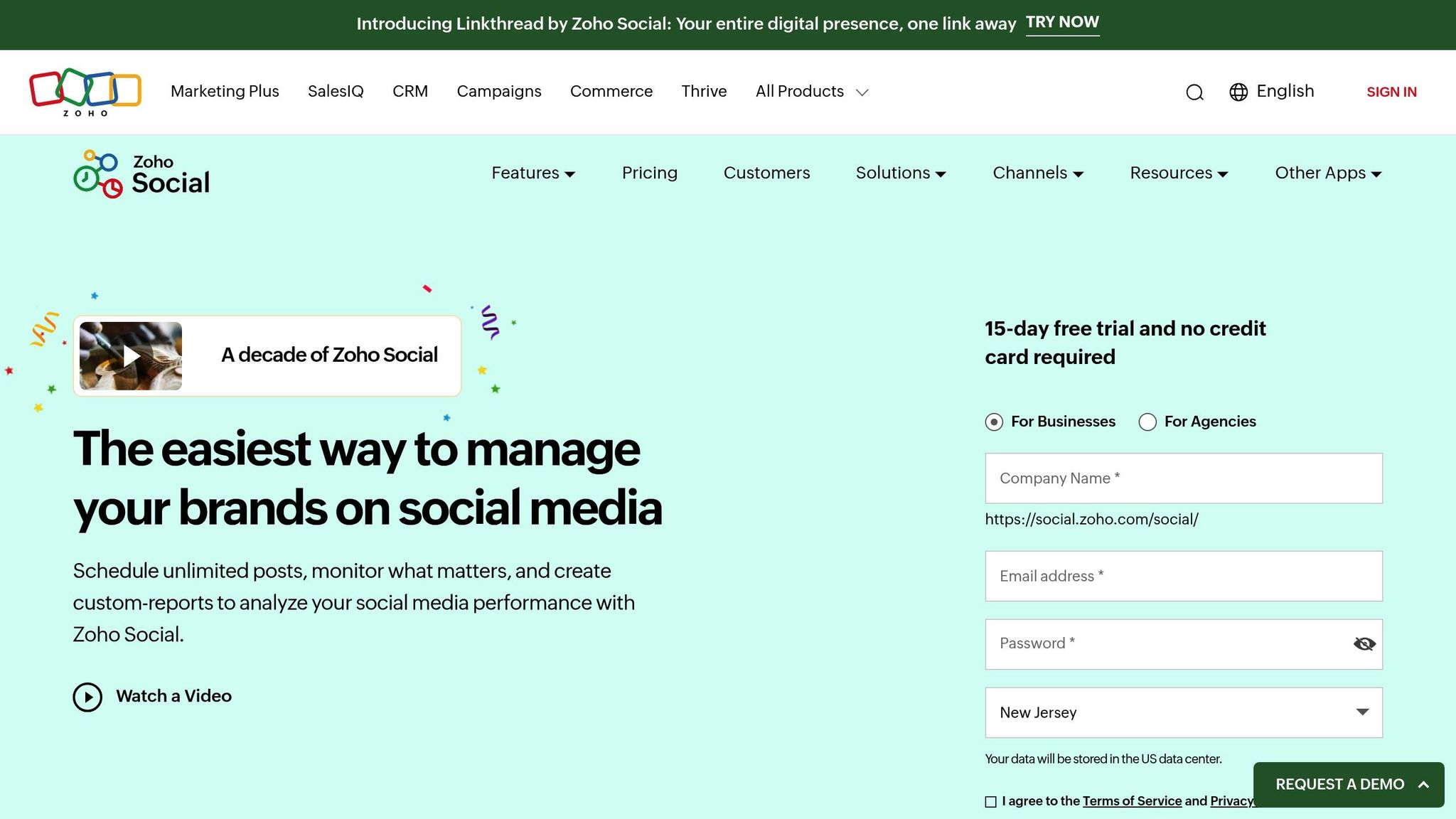
Zoho Social is a robust platform designed for businesses that value seamless scheduling and detailed analytics. It’s especially useful for those already using other Zoho products, thanks to its deep integration with the Zoho ecosystem. This connectivity streamlines workflows, making it a powerful tool for modern marketing teams.
Social Media Management and Scheduling
Zoho Social simplifies scheduling with its Smart Scheduler, which analyzes audience activity to recommend the best posting times. This feature takes the guesswork out of timing, helping you connect with engaged users without constant manual adjustments.
For agencies and businesses managing multiple accounts, Zoho Social offers bulk scheduling via CSV uploads and customizable timetables. You can create tailored posting schedules for each social platform, ensuring your content aligns with the unique habits of each audience.
The platform also includes a visual content calendar, offering a clear, color-coded overview of your scheduled posts across all connected accounts. This layout helps you spot gaps in your content plan or areas where posts might feel overcrowded.
Analytics and Reporting Capabilities
Zoho Social provides detailed analytics to track audience growth, identify top-performing content, and break down follower demographics by platform. These insights help you refine your strategy based on real data.
Its custom reporting feature allows you to create branded reports focused on the metrics that matter most to your business. These reports can be scheduled for automatic delivery to stakeholders, saving you time and keeping everyone on the same page.
Additionally, the platform includes a competitor analysis tool, offering benchmarking data to help you measure your content’s effectiveness against industry standards.
Integration with Other Tools and Platforms
One of Zoho Social’s standout features is its seamless integration with Zoho CRM, which allows you to track social media leads and turn interactions into sales opportunities. This connection provides a full view of how your social efforts contribute to your sales pipeline.
Zoho Social also integrates with Google Analytics, enabling you to monitor how social media traffic translates into conversions. This insight helps you better understand your return on investment.
For teams, Zoho Social supports collaboration with features like approval workflows. Content can be reviewed and approved by managers before it’s published, ensuring brand consistency while allowing distributed teams to work efficiently. These tools make it easier to maintain quality and organization across larger marketing operations.
Pricing and Scalability for Businesses of Different Sizes
Zoho Social offers a 15-day free trial, giving you a chance to explore its premium features before committing to a plan. Its pricing adapts to your needs, with options for small businesses and scalable solutions for larger organizations.
For agencies, Zoho Social includes tools like white-label reporting and client management features, making it easier to handle multiple accounts from one dashboard. As your business grows, the platform’s pricing remains competitive, ensuring it meets your expanding needs.
Up next, CoSchedule brings a sharper focus to content strategy.
6. CoSchedule
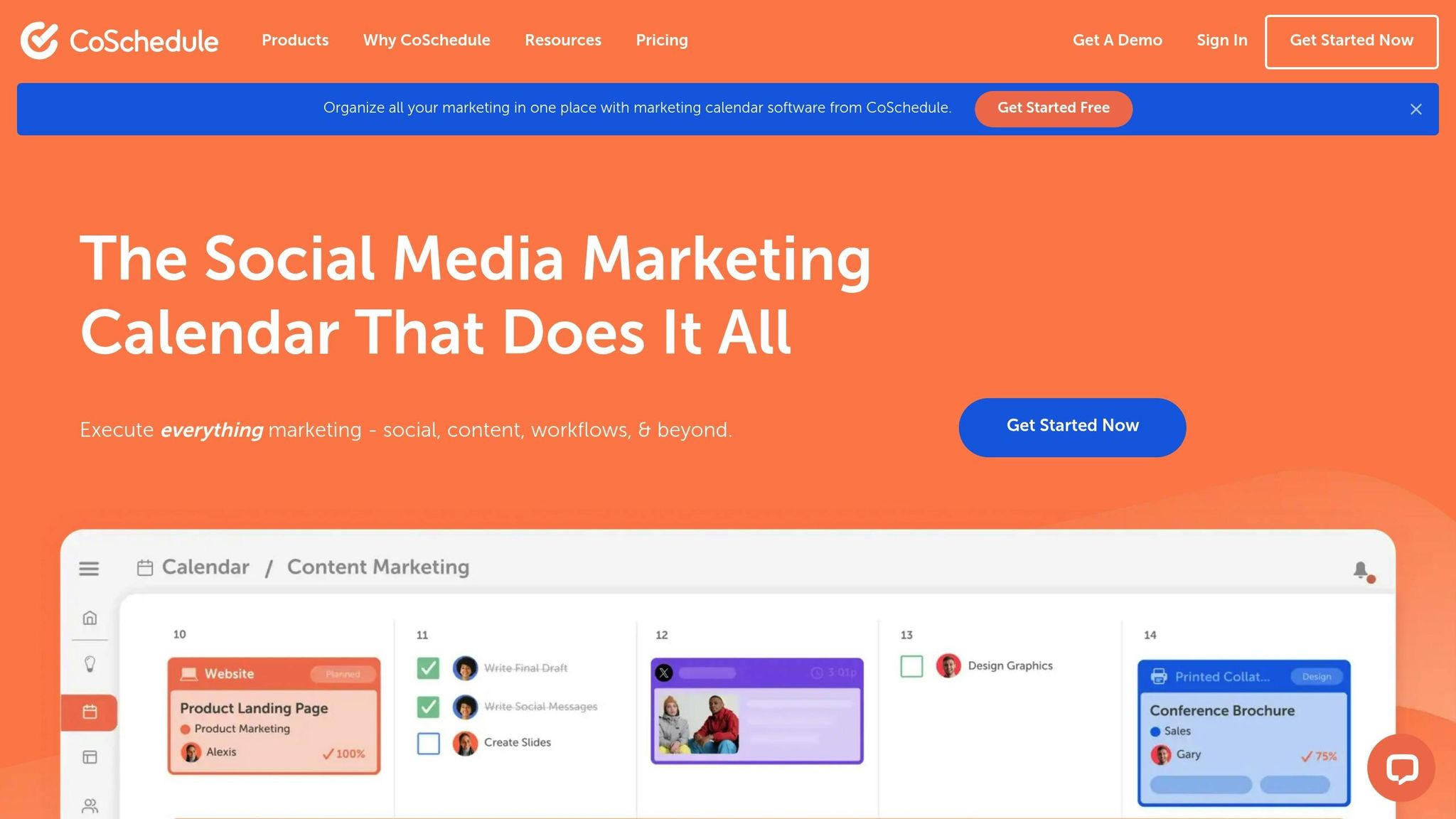
CoSchedule offers powerful tools for analyzing and improving your social media performance.
Analytics and Reporting Capabilities
CoSchedule simplifies performance tracking with its unified analytics dashboard. This dashboard pulls together essential metrics – like clicks, impressions, and shares – from platforms such as Instagram, LinkedIn, Facebook, Twitter/X, TikTok, YouTube Shorts, Bluesky, Mastodon, and Threads. It gives you a clear snapshot of how your content is performing across different channels.
The platform’s AI-Powered Insights Assistant goes a step further by interpreting your data, highlighting unusual trends, and suggesting actionable next steps.
For reporting, CoSchedule provides automated tools with pre-built templates for tasks like monthly reports, campaign reviews, and platform-specific breakdowns. Reports can be exported as PDFs or emailed directly. You can also customize these insights using filters such as social profiles, project types, tags, or color labels. The Social Engagement Report helps you compare performance across channels and pinpoint your most effective content.
With these robust analytics and reporting features, CoSchedule equips you to fine-tune your social media strategy for better results.
7. Birdeye
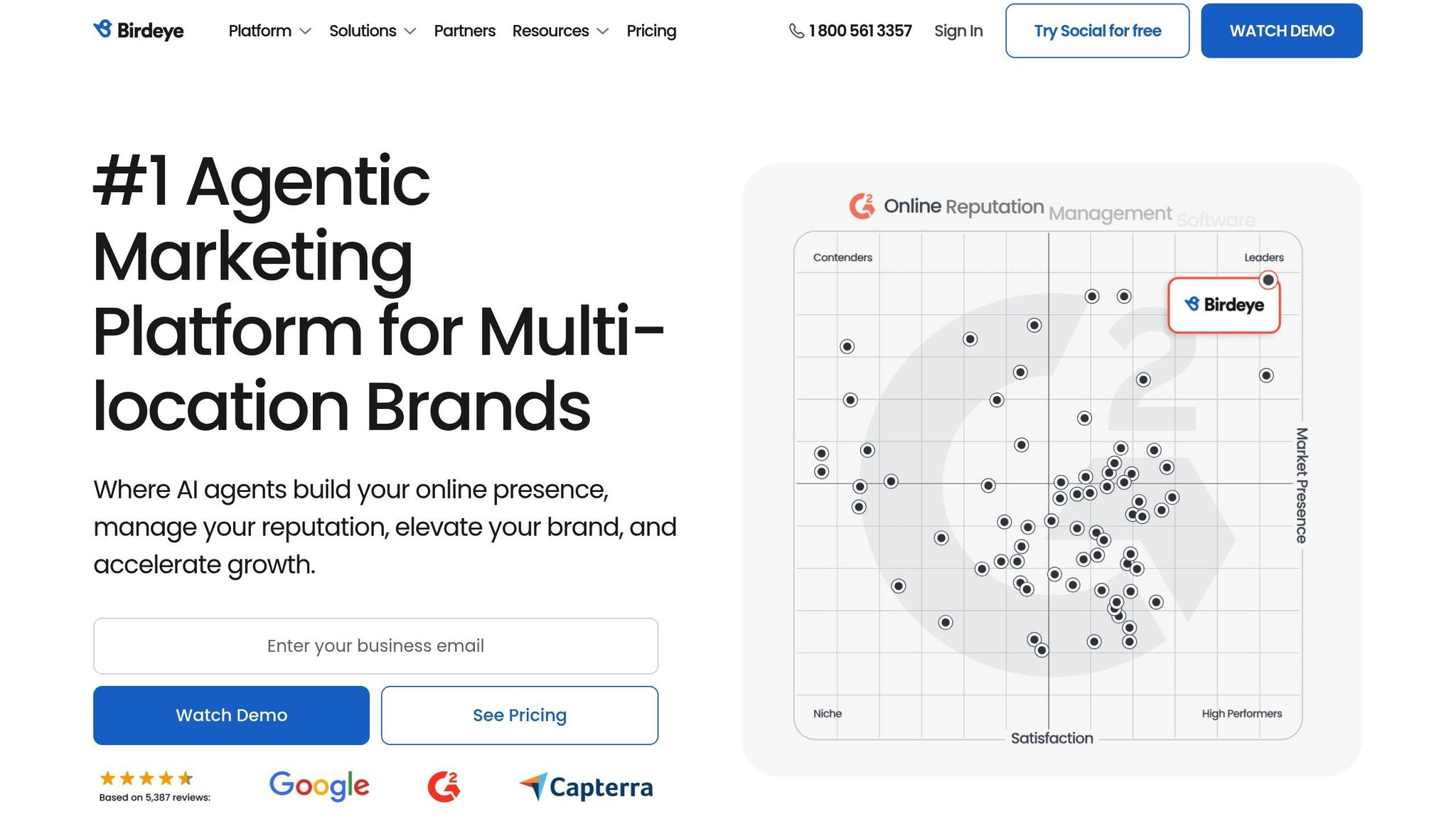
Birdeye brings together social media management and reputation tracking in one platform. It doesn’t just handle the basics like analytics and scheduling – it also offers tools to help you keep tabs on your brand’s reputation. Here’s a closer look at what Birdeye has to offer.
Social Media Management and Scheduling
With Birdeye, managing your social media becomes more efficient. From a single dashboard, you can create, schedule, and publish posts seamlessly. The platform’s automated scheduling ensures your content goes live when your audience is most active. Plus, its content library helps you organize visual assets, making it easier to maintain a consistent brand image.
Analytics and Reporting Features
Birdeye provides in-depth analytics to monitor key engagement metrics like reach, impressions, and follower growth. Its reporting tools help you spot trends over time, while sentiment analysis categorizes social media mentions and comments as positive, negative, or neutral. This feature is particularly useful for identifying potential reputation issues early. Additionally, it tracks response times for social media inquiries, ensuring your customer service stays prompt and reliable.
Integration with Other Tools
Birdeye connects with widely used business tools and CRM systems, syncing customer data with social media interactions for a more complete view of your audience. It also integrates with review platforms like Google My Business and Yelp, allowing you to manage social content and online reviews from one place. For businesses with specific needs, webhooks and API access provide customizable integration options.
Flexible Pricing for All Business Sizes
Birdeye’s pricing structure is designed to work for businesses of all sizes. Whether you’re a small operation or a large enterprise with multiple locations, there’s a plan for you. Custom pricing options make it especially appealing for franchises and multi-location businesses looking to maintain a cohesive social media presence across various sites.
8. SOCi
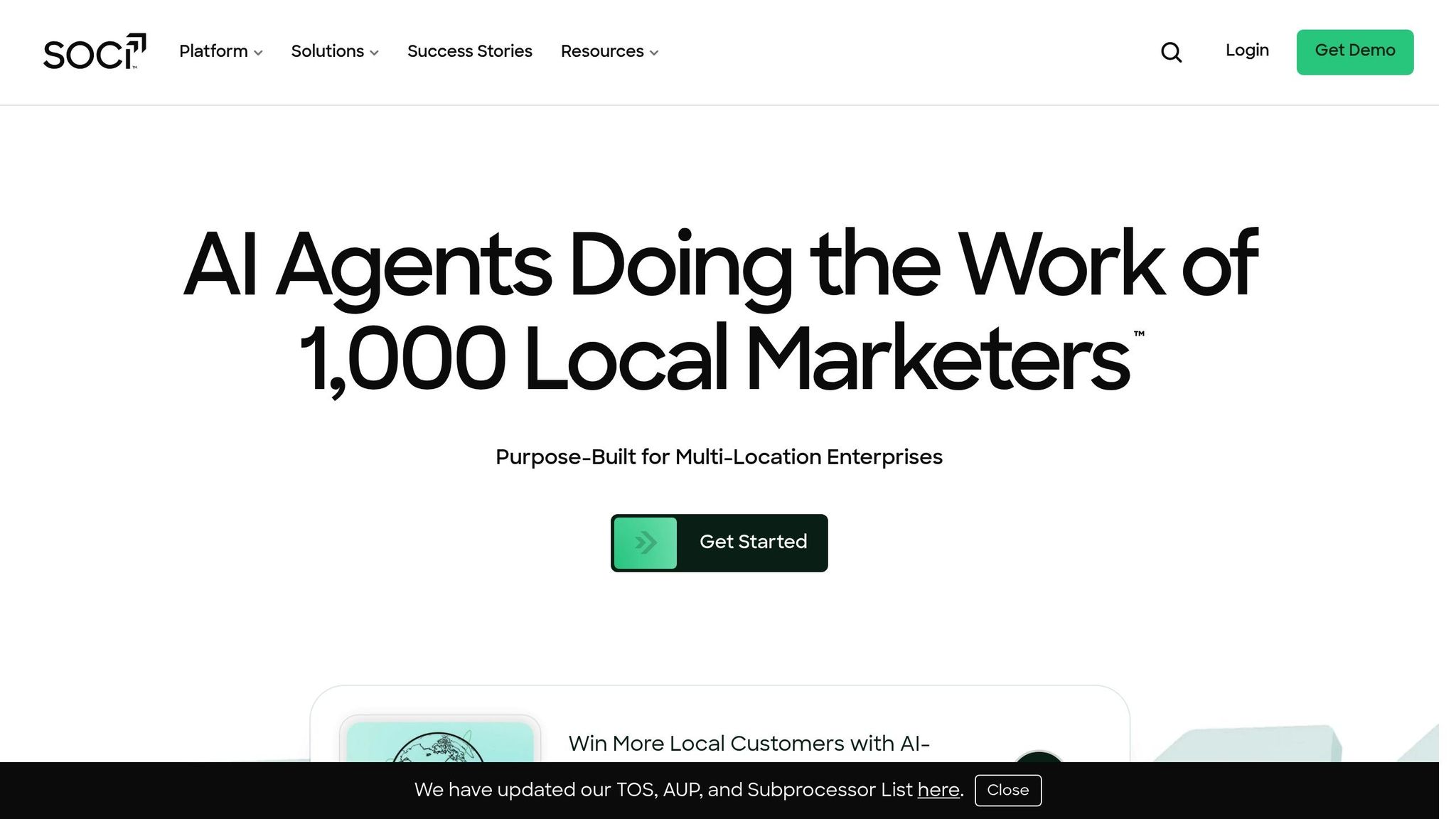
SOCi is a social media management platform specifically designed for businesses with multiple locations. Unlike tools that cater to single-location businesses, SOCi focuses on franchises, retail chains, healthcare providers, automotive dealerships, and hospitality groups. Its features are tailored to help these organizations manage their social media presence across numerous locations, offering solutions for scheduling, analytics, and integrations.
Social Media Management and Scheduling
SOCi’s scheduling tools are built with multi-location businesses in mind. The platform lets you create content templates that maintain brand consistency while allowing for location-specific customizations. Whether you’re posting universally or tailoring content for specific regions, SOCi makes it easy to adjust for local events, promotions, or market trends.
One standout feature is the ability for franchise owners or regional managers to personalize corporate-approved content. This ensures that brand guidelines are upheld while giving local teams the flexibility to connect with their unique audiences in a meaningful way.
Analytics and Reporting Capabilities
SOCi provides analytics that give you both an overview of performance across all locations and detailed insights for individual sites. This helps you see which locations are excelling on social media, identify the types of content that perform best, and uncover trends across different markets.
The platform’s comparative analytics feature is particularly useful for franchises. It allows you to benchmark performance across locations, regions, or timeframes, making it easier to identify successful strategies. Corporate teams can then share these best practices with underperforming locations to improve results across the board.
Integration with Other Tools and Platforms
SOCi integrates with a variety of tools commonly used by multi-location businesses. These include CRM systems, review management platforms, and local listing tools, creating a unified solution for managing your digital presence.
Its integration capabilities extend to location-based services, ensuring that business information like Name, Address, and Phone (NAP) details are consistent across platforms such as Google My Business, social media profiles, and local directories. This consistency is critical for maintaining a strong online presence and building trust with customers.
Pricing and Scalability for Businesses of Different Sizes
SOCi uses a custom pricing model, which means you’ll need to contact their sales team for a personalized quote. Pricing depends on factors like the number of locations, users, features, and integrations required.
This platform is best suited for medium to large businesses with multiple locations. While SOCi can scale seamlessly from a few locations to hundreds, its enterprise-level pricing and features may not be ideal for small businesses or single-location operations. Additionally, the lack of upfront pricing might be a drawback for smaller businesses that prefer clear cost structures before committing to a demo or consultation.
9. Thryv
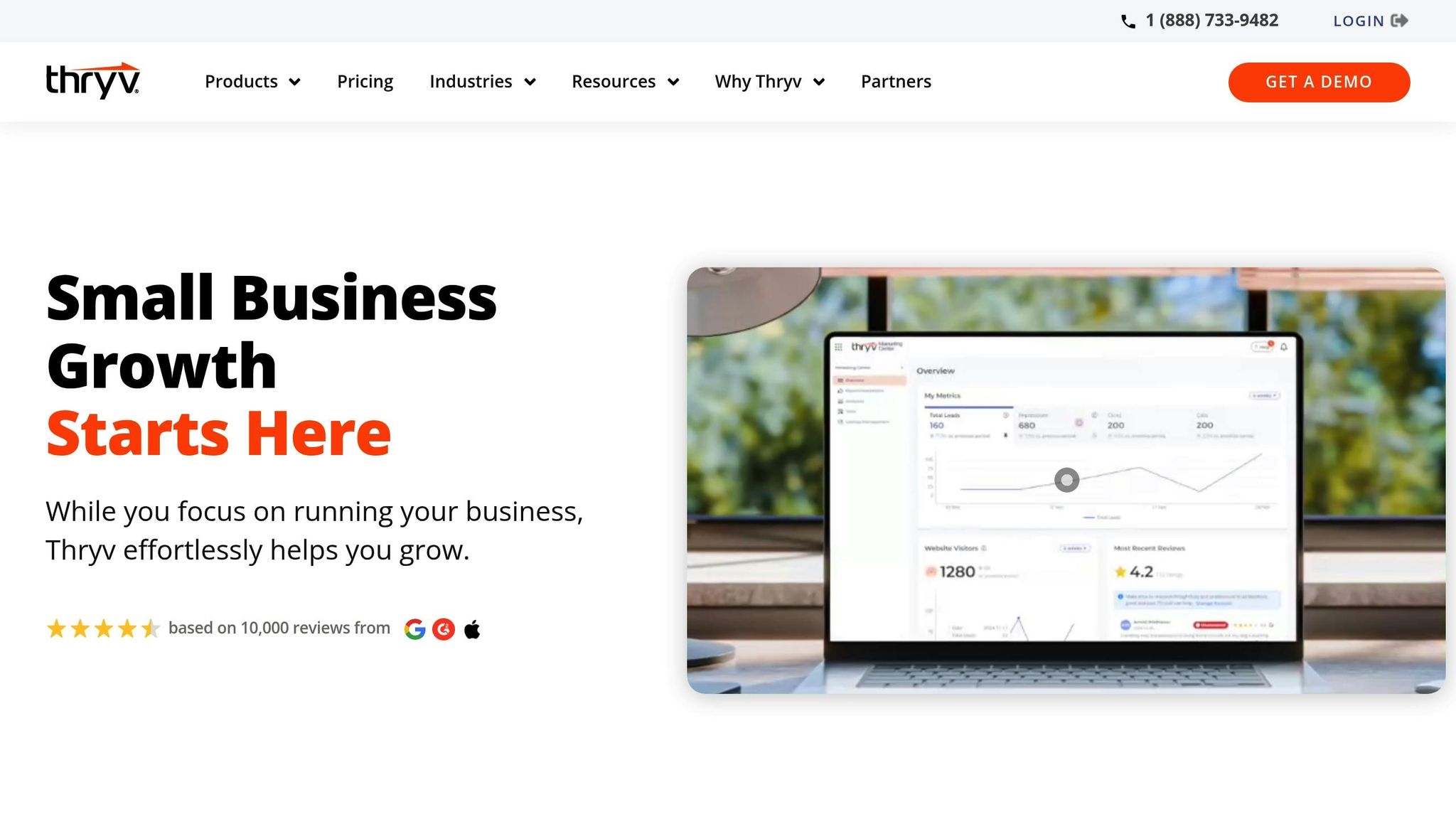
Thryv provides social media insights designed to help small and medium businesses expand their online presence. It focuses on combining scheduling tools with actionable data to streamline marketing efforts. By automatically gathering and analyzing social media data, the platform helps shape more effective marketing strategies. Here’s a closer look at how its analytics features support smarter decision-making.
Analytics and Reporting Capabilities
Thryv pinpoints the content that resonates most with your audience, helping you replicate what works while steering clear of less effective approaches.
It offers detailed audience insights, such as demographics, location, and peak engagement times. Additionally, real-time analytics allow you to monitor campaign performance as it unfolds, ensuring you can make timely adjustments.
Tool Comparison Table
Use the following table to compare key pricing, features, and target users of each tool.
| Tool | Starting Price | Key Features | Best For |
|---|---|---|---|
| Interactive Marketing | $29/month | All-in-one marketing suite, advanced analytics, multi-platform scheduling, lead generation tools | Small to medium businesses looking for a complete marketing automation solution |
| Sprout Social | $249/month | Social listening, team collaboration, detailed reporting, customer care tools | Enterprises with dedicated social media teams |
| HubSpot Marketing Hub | $45/month | CRM integration, email marketing, landing pages, marketing automation | Businesses focused on inbound marketing and lead nurturing |
| Hootsuite | $99/month | Multi-platform management, content curation, team workflows, app integrations | Agencies managing multiple client accounts |
| Buffer | $6/month | Simple scheduling, basic analytics, browser extension, Instagram integration | Solo entrepreneurs and small teams focused on content publishing |
| Zoho Social | $10/month | Social media monitoring, collaboration tools, custom reports, brand monitoring | Small businesses already using the Zoho ecosystem |
| CoSchedule | $29/month | Editorial calendar, content planning, project management, team coordination | Content marketing teams with complex publishing schedules |
| Birdeye | $299/month | Reputation management, review monitoring, customer messaging, local SEO | Local businesses and franchises managing their online reputation |
| SOCi | Custom pricing | Multi-location management, franchise tools, local marketing automation | Large franchises and multi-location businesses |
| Thryv | $39/month | Small business focus, customer management, appointment scheduling, social insights | Service-based small businesses needing an all-in-one solution |
The table above highlights key differences among these tools, helping you identify the best fit for your needs. Pricing varies widely, making options like Buffer and Zoho Social appealing for budget-conscious users, while enterprise-level organizations may lean toward feature-rich platforms like Sprout Social or SOCi.
When it comes to functionality, tools like Interactive Marketing and HubSpot Marketing Hub provide comprehensive suites, while Buffer keeps things simple with a focus on scheduling. For teams, Sprout Social and CoSchedule stand out with collaboration features tailored for larger departments.
Industry-specific needs also play a big role in choosing the right tool. Birdeye is ideal for businesses that rely heavily on online reviews, SOCi caters to multi-location enterprises, and Thryv combines social management with customer relationship tools, making it a great fit for service-based businesses.
This comparison is designed to complement our in-depth reviews, helping you select the tool that aligns best with your marketing goals.
Conclusion
The right social media tools can take your marketing efforts to the next level, turning time-consuming manual tasks into efficient, data-driven campaigns that deliver measurable outcomes. With 94% of businesses using social media and 82% of marketers calling it a core part of their strategy, these tools are no longer optional – they’re a necessity to stay competitive.
From automating post scheduling to tracking performance and monitoring mentions, these platforms simplify your workflow, allowing you to focus on strategy. When 66% of marketers report generating quality leads by dedicating just six hours per week to social media marketing, the benefits of using these tools become undeniable.
Real-time data provided by these tools helps you spot trends, identify engaging content, and determine the best times to post. This ongoing refinement ensures your strategy is always improving. By understanding what resonates with your audience and tracking key metrics, you can make informed decisions that drive results. With 90% of marketers stating that social media marketing has increased their business exposure, the importance of leveraging the right tools becomes even clearer.
Ultimately, the tools you choose should align with your business goals and budget. Investing in quality social media tools not only boosts efficiency and engagement but also paves the way for measurable growth. As AI and automation continue to shape the future of social media, having the right tools ensures your business is ready to adapt, seize opportunities, and maintain a strong, professional presence.
FAQs
What’s the best way to choose a social media tool that fits my business and budget?
When selecting a social media tool for your business, the first step is to define your specific objectives. Are you looking to schedule posts efficiently, track performance metrics, or manage multiple platforms in one place? Once you’re clear on your goals, evaluate the tool’s features and ease of use. Don’t forget to check if it fits your budget – many tools offer free or affordable plans for smaller businesses.
It’s also important to choose a tool that suits your business size, appeals to your target audience, and works well with the resources you have. The right choice can simplify your social media management, boost engagement, and help you see better results for your efforts.
What features should I prioritize in a social media management tool?
When picking a social media management tool, prioritize features that save time and boost results. Start with automation tools that let you schedule and publish posts across various platforms effortlessly. Add to that analytics features to measure performance and understand audience engagement, along with real-time monitoring to handle interactions smoothly.
Other helpful features to consider include support for managing multiple platforms, detailed reporting to assess campaign effectiveness, and a user-friendly interface that makes content creation easier. These tools can simplify your workflow and help you get the most out of your social media marketing efforts.
How does combining social media tools with a CRM system improve my marketing efforts?
Integrating social media tools with a CRM system can transform how you approach marketing. It gives you a comprehensive view of customer interactions across various platforms, enabling you to craft campaigns that are more tailored and relevant to your audience. Plus, you can monitor engagement as it happens and adjust your strategies based on actionable data.
This combination also opens the door to automation – making it easier to respond to inquiries, manage leads efficiently, and enhance customer satisfaction. In the end, this integration simplifies processes, improves ROI, and builds stronger connections with your audience.

